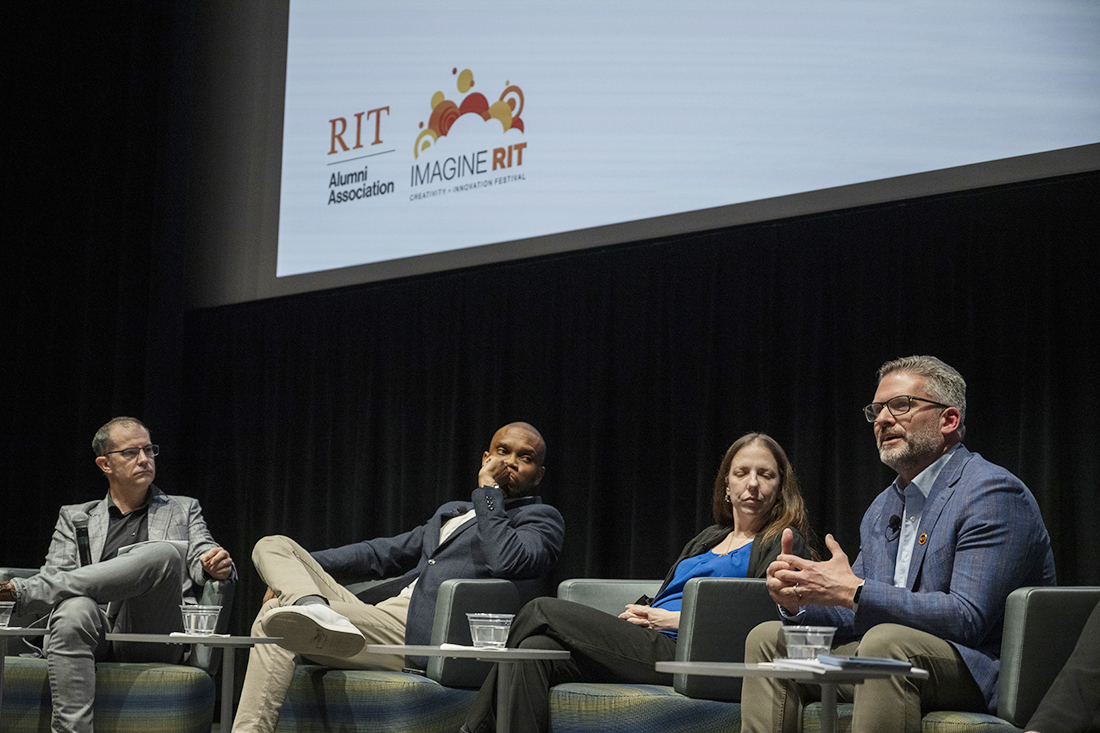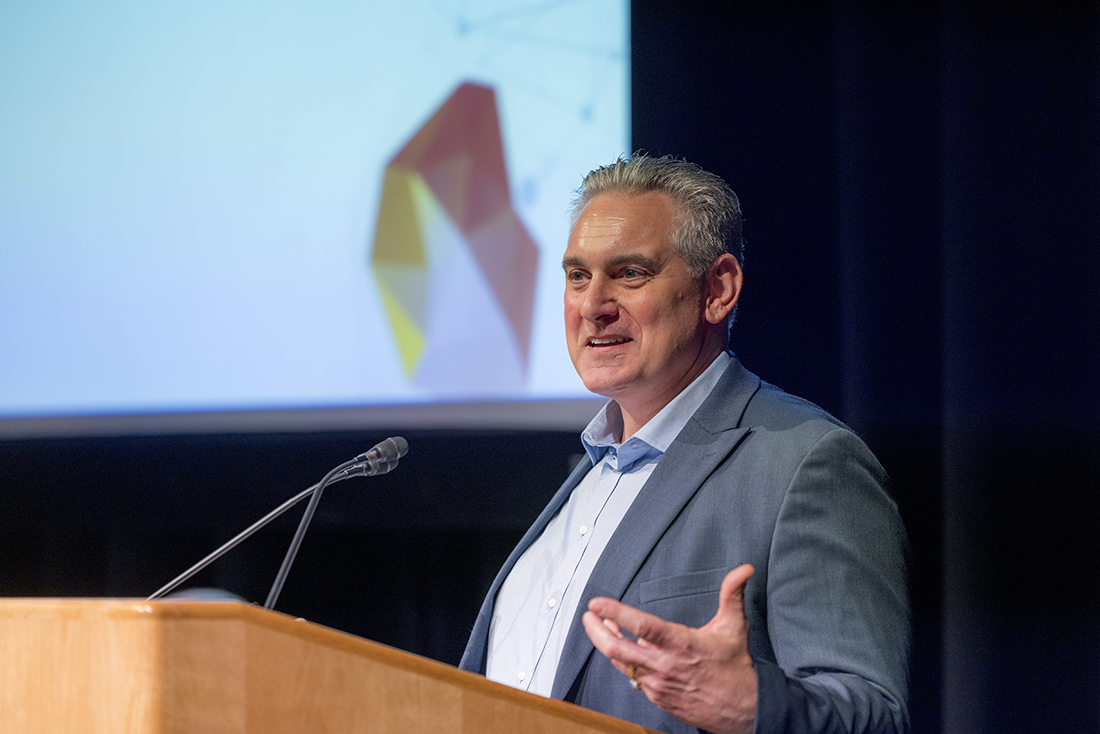From teammates to trailblazers: Alumni push boundaries in tech and healthcare
Bob Morreale, left, and Josh Cavalier were RIT baseball teammates in addition to classmates in the medical illustration program.
From his familiar perch crouched behind home plate, Josh Cavalier remembers the methodical rhythm of Bob Morreale’s pitching windup.
Morreale would pause just long enough for Cavalier's sign, throwing hitters off-balance before delivering a pitch Cavalier describes as “sneaky-fast.” Morreale likens this exchange to an illustrator’s process of partnering with a physician, studying the scientific data, and then applying careful brushstrokes to reveal a clear visual story.
“As medical illustrators and in baseball, we have attention to detail,” Cavalier said. “So I think that’s the way we played.”
Morreale ’92 (medical illustration), ’93 MST (visual arts-all grades) and Cavalier ’92 (medical illustration) formed a natural duo as battery-mates — a term referring to the partnership of a pitcher (Morreale) and catcher (Cavalier) — on the RIT baseball team. The synergy they found both on the diamond and in the medical illustration studio at RIT remains vividly memorable as baseball bonds made way for bold breakthroughs.
After graduating, they embarked on parallel paths, each mastering innovative technologies to improve healthcare and business practices. While both initially leveraged their skills as medical illustrators, they now apply their unique talents in pioneering ways, reshaping how complex information is communicated and understood.
Cavalier started his own company, JoshCavalier.ai, to educate clients — many of whom are Fortune 500 corporations — about the emerging tools and workflows related to generative artificial intelligence. Morreale is the senior division chair for immersive and experiential learning and an assistant professor of biomedical communications at Mayo Clinic College of Medicine and Science in Rochester, Minn.
“RIT introduced me to the transformative power of technology, design, and visual storytelling,” Morreale said. “Although my career evolved beyond traditional medical illustration, I continually find myself drawn back to the meticulous craft of visually unraveling complex medical narratives.”
Elizabeth Lamark
Bob Morreale, far right, serves on the panel of the 2024 Futurists Symposium, RIT's annual event highlighting the accomplishments of the university's alumni and faculty innovators.
With prior leadership roles at The Johns Hopkins Hospital and Cleveland Clinic, Morreale’s two-decade journey at Mayo Clinic began by leading its medical illustration team. Over the years, he pioneered visual communication techniques that have significantly enhanced medical education, patient engagement, and scientific discovery.
He oversees a large team dedicated to revolutionizing medical education, research, and healthcare workforce training through emerging technologies such as spatial computing, extended realites (AR/VR), 3D printing for surgical planning, and artificial intelligence (AI).
At Mayo Clinic, Morreale has pursued several ambitious projects. He reimagined existing educational spaces with a digital light studio and high-resolution capture system and also developed immersive deployment environments where learners engage in hyper-realistic virtual training scenarios with seamless access to AI-expert digital humans based on real-life faculty and mentors. Additionally, he co-founded a tech start-up (neuRealities) that merges spatial computing and AI to scale enterprise immersive experiences on an open standards platform.
“It’s incredibly rewarding and genuinely exciting,” Morreale said. “With the rapid evolution in technology, it feels like I’m just getting started all over again.”
Provided
The 1988-89 RIT baseball team — featuring Bob Morreale (middle row, fourth from left) and Josh Cavalier (middle row, sixth from left) as teammates.
Cavalier primarily works with learning and development departments to help organizations integrate AI into their workflows — from establishing company AI policies and leveraging the technology to augment productivity to employee training. His consulting, workshops, and courses are the result of decades of experience teaching professional growth strategies using innovative approaches.
“It’s this conversation around humans interacting with machines as a multiplier with artificial intelligence that has my attention,” Cavalier said. “I’m in the business of human performance, and AI can be a catalyst for that if it’s done properly. Throughout my career, this balance of art and science has always been there, and it’s shown up in various ways.”
Dating back to RIT, Cavalier was drawn to cutting-edge technology. Working with computers in the early 1990s gave him his first taste of multimedia communication. He was hooked, and was soon learning computer software and developing e-learning content.
Traci Westcott
Josh Cavalier during RIT's latest Futurists Symposium in April 2025.
Before starting JoshCavalier.ai, he owned another company, Lodestone, offering skills training programs. Cavalier said it was a top Adobe-authorized training provider in the country.
“The dynamic of how humans interact with machines has always been an interest of mine,” Cavalier said. “That’s what got me down this path.”
Both Cavalier (2025) and Morreale (2024) were panelists for RIT’s annual Futurists Symposium the last two years. They presented on their explorations in technology, the arts, and design, and how those led to innovative advancements.
Their baseball careers may be behind them, but Cavalier and Morreale still offer their best pitches and swing for the fences in their professional lives.
“More than 30 years later, my tools and titles have changed along the way,” Morreale said. “But I’m forever drawing from the same blend of science, technology, and art that I learned as a medical illustrator.”
















